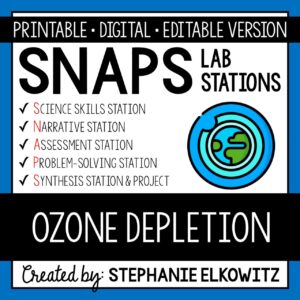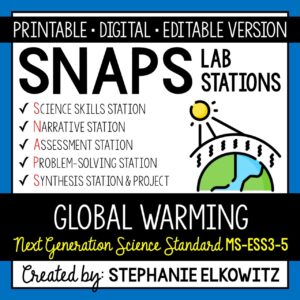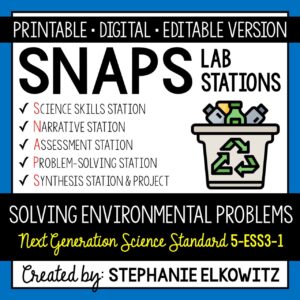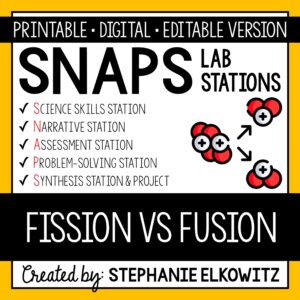Muscular and Skeletal System Lab
$7.00
An engaging lab activity designed to enhance students’ understanding of locomotion and functions, structures and diseases of the muscular and skeletal system.
Description
Musculoskeletal System Lab Preview
SNAPs Lab Stations Activities require students to use science, math, literacy, problem-solving and engineering skills. They are designed to enhance students’ understanding of scientific concepts and help students apply scientific ideas to the real world. Each station activity promotes skills so to develop students into proficient and competent scientific thinkers.
SNAPs lab activities have five components:
• Science Skills Station to develop science skill proficiency
• Narrative Station to build science literacy
• Assessment Station to evaluate learning and understanding
• Problem-Solving Station to foster engineering design
• Synthesis Station and Project to inspire higher-order learning
DIGITAL LABORATORY – DISTANCE LEARNING & DIGITAL CLASSROOMS
• This lab is offered in a digital format to support digital classrooms & distance learning.
• The digital lab activity is designed to work with Google Slides and Microsoft PowerPoint
• The digital lab activity CANNOT be edited. However:
– Students can manipulate text boxes
– Students can create tables, graphs and diagrams
– Students can insert images and drawings
GOOGLE FORM ASSESSMENT STATION
• The assessment station is offered as a self-grading Google Form.
• Questions are all short answer and are 100% editable.
• Suggestions for use are included in the download.
DISTANCE LEARNING COMPATIBILITY
SNAPs lab activities are rated for their ease with distance – independent learning. Refer to the preview for more information about how well this laboratory works in a fully digital classroom and with distance learning.
EDITABLE DOCUMENTS
This download includes an editable word document (docx file) of all lab components:
• Pre-Lab and Post-Lab Activities
• The Lab Overview
• Lab Station Activities and Questions
• Directed Synthesis Project (when applicable)
Important Notes:
• Diagrams, illustrations, tables and graphs essential to lab activities are included
• Illustrative clipart is NOT included
• Editable documents and rubrics are included with the FREE SNAPs Setup Guide
Editable files allow you to:
• Edit the scope of the activities so to suit your students’ needs
• Edit the materials required based on resource availability
• Create single-period “mini-labs” using activities at the individual skills stations
The activities at each station in this lab are detailed below.
**Watch a video demonstration of the Musculoskeletal System Science Skills Activity #1 on YouTube or SafeShare.TV**
Musculoskeletal System Lab Stations Activity Learning Objectives
1. Discuss the functions and major components of the skeletal and muscular systems.
2. Compare and contrast smooth muscle, cardiac muscle and skeletal muscle.
3. Compare and contrast the axial and appendicular skeleton.
4. Study the relationship between bones and muscles using a model to understand how the organ systems work together so to provide locomotion.
5. Conduct an investigation to evaluate muscle fatigue.
6. Diagnose diseases affecting the skeletal and muscular system and determine treatment and outcomes for those diseases based on current medical practices.
Science Skills Station
Students will build a model of an arm to study the elbow joints and the relationship between bones, muscles and other structures that allow for locomotion. Students will also conduct an investigation to evaluate muscle fatigue that results from lactic acid buildup.
Narrative Station
Students will watch videos about the muscular and skeletal systems. Students will read about the three different types of muscles and the structure and function of the axial and appendicular skeleton. Students are provided enrichment videos about bone marrow transplants, growing bones, muscle growth and [anabolic] steroid effect on muscle growth.
Assessment Station
Students will answer questions about key terms and ideas relating to the skeletal and muscular systems and their role in locomotion. Students must employ lower, mid and higher order thinking skills to answer these questions.
Problem-Solving Station
Students will diagnose diseases affecting the skeletal and muscular systems. They will be provided symptoms and lab results, from which students will create a differential and a final diagnosis. Students will determine the patient’s most likely treatment and prognosis.
Synthesis Station
Students will compose a CER (claim-evidence-reasoning) report to summarize the lab. Students are provided the claim statement and must support the claim with observations, data and other information gathered in the lab. Students will explain how the evidence supports the claim using scientific reasoning.
Synthesis Project
Students will have a choice of 11 projects. Refer to the SNAPs Lab Stations Best Practices and Setup Guide for directions and suggestions on how to conduct the project.
This download includes:
• A pre-lab assignment and post-lab reflection
• Directions and questions for each lab station
• Student recording sheets
• Teacher Key
Additional Materials Required:
3 Computers or tablets
1/8th inch hole puncher
Cardstock
1/8th inch wooden dowels
Rubber bands
Red or pink long balloons
Long balloon pump
Clear tape
Orange and yellow tape*
Latex gloves (optional)
Ruler
Stopwatch
Clothespins
LINKS TO VIDEOS
This laboratory requires internet to access videos. Videos are hosted on SafeShare.TV so to safely watch and share educational YouTube videos without ads, comments and other distractions. Full and shortened links to original YouTube videos are included.
NEXT GENERATION SCIENCE STANDARDS
This laboratory does not address a specific Next Generation Science Standard, but it complements NGSS concepts. It combines the three dimensions of science learning – science and engineering practices, disciplinary core ideas and crosscutting concepts – in order to meet the standard. This laboratory also makes interdisciplinary connections to STEM, Math CCSS and ELA CCSS to build the appropriate skills.
TERMS OF USE
• All rights reserved by Stephanie Elkowitz.
• This product is to be used by the original purchaser only.
• Intended for classroom and personal use only.
• Copying for more than one teacher, classroom, department, school, or school system is prohibited.
• This product may not be distributed or displayed digitally for public view.
• Failure to comply is a copyright infringement and a violation of the Digital Millennium Copyright Act (DMCA).








